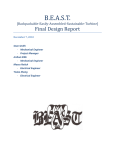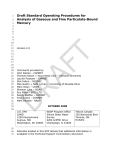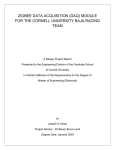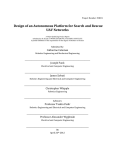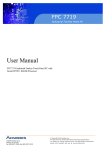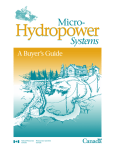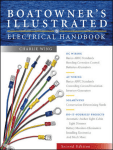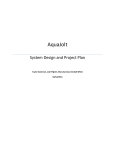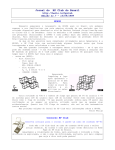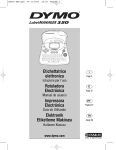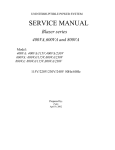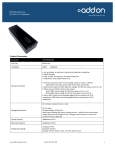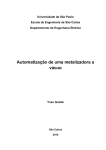Download Interim Design Report
Transcript
AQUAJOLT 12/7/2011 Interim Design Report Taylor Gammon, Josh Pilgrim, Mary Samoei, Kendall White AquaJolt TABLE OF CONTENTS REQUIREMENTS SPECIFICATION ............................................................................ 3 Overview................................................................................................................. 3 Mission Statement .................................................................................................. 4 Deliverables ............................................................................................................ 4 Operation ................................................................................................................ 4 Customer Needs .................................................................................................... 4 Technical Specifications ........................................................................................ 5 Needs Metrics Matrix ............................................................................................. 6 Testing Plans .......................................................................................................... 7 Implementation Considerations ............................................................................. 7 SYSTEM DESIGN ......................................................................................................... 8 Background ............................................................................................................ 8 System Overview ................................................................................................... 8 Functional Decomposition of Blocks ...................................................................... 9 Organization and Management ........................................................................... 13 MECHANICAL DESIGN ............................................................................................. 14 Turning Mechanism ..................................................................................................... 14 Water Wheel ........................................................................................................... 14 Power and Efficiency .............................................................................................. 19 Flotation Mechanism ................................................................................................... 20 Anchoring..................................................................................................................... 23 Gearing ........................................................................................................................ 27 Debris Guard ............................................................................................................... 29 Generator Selection .................................................................................................... 30 Back-EMF ............................................................................................................... 31 Housings and Mountings ............................................................................................. 35 Wheel Support ........................................................................................................ 35 Generator ................................................................................................................ 36 Waterproof Electrical Housing ................................................................................ 38 ELECTRICAL DESIGN ............................................................................................... 39 Battery .................................................................................................................. 39 DC to DC Step Down ........................................................................................... 41 Power Status Indicators ....................................................................................... 45 Battery Status Indicator ........................................................................................ 47 Voltage Monitor .................................................................................................... 49 Charge Regulator ................................................................................................. 52 Inverter Design ..................................................................................................... 56 1 AquaJolt PROJECT MANAGEMENT ........................................................................................ 60 Budget Analysis.................................................................................................... 60 Work Breakdown Structure and Schedule Analysis ............................................ 68 APPENDIX A: LTC3789 DATASHEET....................................................................... A APPENDIX B: MAX6458/6459 DATASHEET ............................................................ B APPENDIX C: MAX8212 DATASHEET...................................................................... C APPENDIX D: LM350 DATASHEET .......................................................................... D APPENDIX E: BATTERY DATASHEET ...................................................................... E APPENDIX F: MAIN SHAFT BEARINGS DATASHEET ............................................ F APPENDIX G:INTERMEDIATE SHAFT BEARING DATASHEET ............................ G APPENDIX H: SHAFTS DATASHEET ....................................................................... H APPENDIX I: SPROCKETS DATASHEET ................................................................... I 2 AquaJolt Requirements Specification OVERVIEW In today’s world, electricity is a vital resource that is utilized in almost every nation. Electricity powers devices that many people cannot seem to live without, such as computers, cell phones, lights, refrigerators, and countless other products that define life in the twenty-first century. Electrical power generation has historically depended heavily on the consumption of fossil fuels. However, this dependence on fossil fuels has created a false carrying capacity for the globe, allowing humans to enjoy a higher standard of living than the earth can sustainably provide. Fossil fuels are a limited resource, and we consume them at a faster rate than the world can produce them. As fossil fuels continue to increase in price and decrease in availability, sources of alternate energy are becoming critical for supplying all our energy needs. Humanity has tried to harness the sun, the wind, even the movement of the tides in order to capitalize on nature’s perpetual sources of energy. These alternative energy generation methods are based on renewable energy sources and have significantly less negative environmental impact than fossil fuels. One common form of energy that has been harnessed since the Hellenistic period is the force of a flowing body of water. Unlike solar or wind generation methods, which depend heavily on ideal weather conditions, hydroelectric generation depends on a reliably consistent source of renewable energy. Hydroelectricity is an environmentally friendly, perpetual source of energy that has less risk than fossil fuel or nuclear power generation. Many developing nations do not have the capability of generating power on a large enough scale to deliver a constant source of electricity to each home. Most homes in those nations are not connected to an electrical grid like we are accustomed to in the United States. However, people in this part of the world still own small electrical appliances, such as cell phones and radios. With the increasing technological advancements in the cell phone industry, phones are capable of connecting these people to the rest of the world in a way that was previously impossible. However, it is difficult for them to find places to charge these devices consistently. A device that could generate enough electrical energy to power these small devices along with any other small appliance on hand would be extremely useful. Our portable hydroelectric generator seeks to address some of the electrical generation deficiencies faced by many people in developing nations across the world. The device will utilize hydroelectric generation methods to power small personal appliances, such as cell phones and radios. The device would be placed in a moving body of water and be able to safely generate electricity that can be sent directly to the appliance or to a battery for later use. The AquaJolt portable hydroelectric generator will allow people with limited resources to power electronic appliances that connect them to the rest of the world in ways that were previously impossible. 3 AquaJolt MISSION STATEMENT The goal of this project is to design a hydroelectric generator for small scale applications, using information from existing designs for large scale use. This small-scale generator will provide a constant source of electricity in places or situations where reliable power sources are scarce. A portable hydroelectric generator could be used in developing countries in order to supply individuals with a reliable source of electricity. Using gasoline powered generators in these settings can be a difficult proposition, due to the lack of steady supply lines needed to constantly fuel them. This product will also provide energy at a much lower cost than fossil fuel generators. The apparatus is intended to be a temporary source of power, and the portability of the device allows users to transport it easily from one location to another. DELIVERABLES 1. Portable Hydroelectric Generator 2. System Specifications 3. Test Results 4. User Manual 5. Final Report OPERATION The portable hydroelectric generator will be placed in a moving body of water and secured so that it does not float away. Once installed, the device will convert the kinetic energy of the moving water into usable electrical energy through a generator. The user will be able to choose whether the energy will be sent directly through an inverter to the appliance to be charged, or if the energy will be stored in a battery to be used at a later time. If the user wants to charge an appliance directly, the power will be inverted and sent to a standard AC (120 VAC, 60Hz) outlet where a single appliance may be plugged in. The power generation will be monitored to verify the state of the output energy. CUSTOMER NEEDS 1. 2. 3. 4. 5. 6. 7. 8. 9. Lightweight Packable and portable Easy to install Low noise level Appears finished Powers multiple appliances No risk to user or environment Low maintenance Durable 4 AquaJolt TECHNICAL SPECIFICATIONS 1. Power output for multiple appliances - supplies, at a minimum, 50W at 120VAC to a standard outlet. 2. Lightweight- Less than 25 kg, or can be easily separated into at most four pieces that are less than 25 kg each. 3. Portable – Fits through all standard doorways (0.81m x 2.1 m). 4. Easy to install - Capable of being installed within one hour by a single person after reading the user manual. 5. Appears finished - No dangerously exposed moving parts or wires. 6. Durable - Able to withstand transport. 7. Low noise level - Produces less than 100 dB when operating from a distance of two meters. 8. Very low maintenance – Does not require adjustment or handling in a six hour period. 9. No risk to user or environment - Electrical components are water proofed/shielded, there are no sharp edges exposed, does not harm wildlife, and contains no toxic materials. 10. Functions in most rivers - Requires a water velocity of at least 1 m/s and a minimum depth of 0.6 m. 5 Light Packable Easy to install Low noise level Appears finished Powers multiple appliances No risk to user or environment Low maintenance Durable X X X X X X X X X X Can survive frequent transportation and installation. Mechanism is protected. X Does not require constant supervision. No sharp corners, all electrical components waterproofed. Generates at least 50W of power. No exposed moving parts or exposed wires. The product will produce less than 100 dB of sound while operating. The product will possess handles or straps on unwieldy sections. Requires no special training. Capable of being installed by a single person after reading the user manual within one hour. Can be disassembled into parts that weigh no more than 25kg each. AquaJolt NEEDS METRICS MATRIX X 6 AquaJolt TESTING PLANS 1. The assembly will be weighed using a bathroom scale. A person will first be weighed and the weight recorded. The person will then hold the assembly and step on the scale. The weight will be recorded. The difference will then be calculated and converted to a mass. The assembly’s dimensions will also be measured with a tape-measure and compared to the dimensions of a standard door frame. This test will ensure that the generator retains its portability. 2. The generator should be able to produce an average of 50 watts over a six hour period given a flow rate of at least 0.5 m/s. 3. The assembly should be able to be built in less than one hour by an individual after reading the user manual. This test will be performed by four users, and the mean time of the installation will be calculated. A mean time of less than one hour will be considered a success. 4. The generator will be loaded into a pickup truck and transported at least 15 km on dirt roads. If it still functions properly, then it passes the test of durability. IMPLEMENTATION CONSIDERATIONS The apparatus surrounding the generator must be built out of affordable materials that are readily available. The target market of this device is for people in very remote areas with limited resources to expensive manufacturing processes. Lightweight materials such as wood, aluminum, and plastics are all plausible options for constructing the device. The generator itself must be purchased separately. It is not constructed by the product developers of this device. The construction should not require highly advanced manufacturing skills in order to assemble. 7 AquaJolt System Design BACKGROUND Our world is becoming increasingly mobile. As cellular phones continue to increase in versatility and range, a demand for a reliable source of power in remote locations continues to grow. No group is more interested for decentralized energy than are developing countries. As of 2009, over 1.4 billion people, primarily living in Africa and Asia, have little to no access to electricity1. Even if the people of these nations have been able to procure some sort of conventional generator, they soon find themselves forced to rely on fossil fuels if they desire an electricity source. These generators possess a number of inherent flaws that limit their usefulness, such as the cost and weight involved in transporting fuel long distances over potentially difficult terrain. The obvious solution to these issues is to use a generator that is powered by a renewable energy source, such as solar, wind, or hydro power. However, solar and wind power both rely heavily upon weather conditions of a given area in order to produce a usable amount of electricity. Hydro power possesses a unique advantage: if the body of water is chosen judiciously, hydro power can be considered a constant source of power. SYSTEM OVERVIEW Aquajolt, the portable hydroelectric generator, would answer all of these problems. Since the residents of these countries possess little in the way of what most Westerners would consider large appliances, the power output of such a device would not have to be very large. Even 50 watts would be enough to power the small devices that are common in such areas. Aquajolt will consist of a turbine attached to a floating platform and anchored in a moving body of water. The turbine will convert the kinetic energy of the water into rotational energy which is translated through a gear system to a generator. The generator then supplies power to an on-shore charging station via a waterproof cable. The device can be disassembled into at most four parts with each part weighing no more than 25 kg (≈55 lbs) in order for it to retain its portability. The on-shore station will contain a battery that is charged by the generator. The battery will be protected from overcharging through a charge regulation circuit. An indicator will display the remaining potential of the battery. The station is also equipped with an inverter to convert the DC output of the battery to 120VAC, which will then be connected to an outlet. Another indicator will show whether there is sufficient power being supplied from the battery to the inverter so that the inverter can function. 1 http://www.iea.org/weo/electricity.asp 8 AquaJolt FUNCTIONAL DECOMPOSITION OF BLOCKS The following diagrams detail the overall block diagram of the system. The numbers found are based off of water flow rates from 0-5 m/s. The output of the generator was estimated using the experimentally determined values outlined in the “Back-EMF” section of this report. The water exit flow rates are based on a 40% energy capture rate and the torques are based on a cross-sectional area of 0.28 m2. FIGURE 1: LEVEL 1 FUNCTIONAL SYSTEM BLOCK DIAGRAM 9 AquaJolt FIGURE 2: TURNING MECHANISM SUBSYSTEM FUNCTIONAL BLOCK DIAGRAM FIGURE 3: CONTROL CIRCUITRY FUNCTIONAL BLOCK DIAGRAM 10 AquaJolt Floatation Mechanism: The buoyancy system keeps the turning mechanism at the optimum depth in the water, allowing the Poncelet blades to enter the water at a very small angle in order to take advantage of the blade’s unique design. The buoyancy will be enough to keep at least 100 kg (≈220 lbs) afloat. To create a buoyancy force able to keep that much weight afloat, 0.1 m 3 of water must be displaced. This value for the weight of the device is based off of the worst case scenario of the weight specifications listed above. For our flotation mechanism and blade length, we anticipate a need for a river depth of at least 0.6 m. Waterproof Housing: This keeps the sensitive electrical components of the generator safe from the spray of the river. The housing is made of plexiglass, sealed with epoxy to ensure a watertight seal. Debris Guard: This device serves to keep any wildlife or floating material in the water from hampering the movement of the wheel. It will consist of a simple wire mesh that protects the wheel from oncoming debris. Waterproof Electrical Housing: This section houses all of the electrical components of the system (circuits, battery, and inverter). It has a user interface that contains the LED outputs of the battery status indicator and the power status indicators, as well as a switch that the user can flip to select where the inverter is powered from. It also has a standard AC outlet so that a device can be plugged into it. The housing will protect the components from the elements and also keep them safe during normal use and transport. The section will be placed on the shore. Turning Mechanism: This part of the device will be placed in a moving body of water and will function by converting the kinetic energy of the water into mechanical energy. The rpm and torques are calculated using a wheel diameter of 1 m and a cross –sectional paddle area of 0.28 m2 and includes a 40% efficiency loss from velocity of the water to velocity of the wheel. INPUT: Water, 0-5 m/s OUTPUT: 0-38 rpm, 0-1750 N-m, water 0-3 m/s Gear System: The torque and rpm of the turning mechanism will be sent through a system of gears to increase RPM at the cost of torque. The desired ratio is anticipated to be at least a 10:1 gearing ratio. This also includes a 97% efficiency consideration. INPUT: 0-38 rpm, 0-1750 N-m OUTPUT: 0-369 rpm, 170 N-m Output Shaft: The shaft transmits the altered torque and rpm to the generator. The DC power generated is taken experimental data shown in the section labeled “Back-EMF”. INPUT: 0-369 rpm, 170 N-m OUTPUT: DC power (0-65 V, 0-4 A) DC to DC Step Down: This section will take the DC power from the generator and drop it down into a range that is acceptable for the battery and the inverter. INPUT: DC Power (0-65 V, 0-4A) 11 AquaJolt OUTPUT: DC Power (0-14 V, 0-5 A) Charge Regulator: This device will prevent the battery from becoming overcharged. It allows power to pass through until the battery is fully charged. Once it is charged, the charge regulator stops the battery from charging. In addition, it also keeps the battery from returning charge to the generator when insufficient torque is applied to the wheel. It also has a current regulator to keep the current at a safe level for charging the battery INPUT: DC Power (From DC to DC Step down: 0-14 V, 0-5 A) DC Power (From Voltage Monitor: 0-5 V, 0-35 mA) OUTPUT: DC Power (0 or 0-14 V, 0-3 A) Voltage Monitor: The voltage monitor checks the voltage on the battery to make sure it does not raise above the specified level for the battery (12 V). If the voltage on the battery is lower than 12 V, it sends a high signal out to the charge regulator, allowing power to be supplied to the battery. Once the voltage on the battery rises above 12 V, the voltage monitor sends out a low signal to the charge regulator to supplying power to the battery INPUT: DC Power (0-12 V, 0-20 mA) OUTPUT: DC Power (0-5 V, 0-35 mA) Battery Status Indicator: The charge status indicator will show how much capacity is left on the battery, as a percentage, by measuring the voltage. The voltage range for this application is from 10.5V to 12.75V. If the battery gets below this voltage, it becomes unusable. Therefore, 10.5V was selected as 0% of capacity. INPUT: DC Power (0-12.75 V, 0-100 mA) OUTPUT: Remaining voltage on the battery, shown in a percentage through a range of LEDs. Switch: The switch will allow the user to select if power is sent to the inverter from the battery or straight from the generator, or if no power is sent, according to the output of the power status indicators. INPUT: DC Power (0-14 V, 0-5 A from Generator; 0-12 V, 0-10 A from Battery), User Selection OUTPUT: If in one of the on positions, DC Power (0-14 V, 0-5 A from Generator; 0-12 V, 010 A from Battery). If in the off position, there is no output.. Battery: The battery will store the power produced by the generator. INPUT: DC Power (0-14 V, 0-3 A) OUTPUT: DC power (0-12 V, 0-10 A) Generator Power Status Indicator: The generator power status indicator will determine if the inverter is being supplied sufficient DC voltage to operate (10-15 VDC). It will use comparators to determine if the voltage is within the specified range. If it is, a green LED will turn on. If not, a red LED will turn on. This will let the user know if it is okay to turn on. INPUT: DC Power (0-14 V, 20 mA) OUTPUT: Green or Red LED will be illuminated. DC Power (0 V, 1 mA or 11.5-14.5 V, 10 mA) 12 AquaJolt Battery Power Status Indicator: The battery power status indicator will determine if the inverter is being supplied sufficient DC voltage to operate (10-15 VDC). It will use comparators to determine if the voltage is within the specified range. If it is, a green LED will turn on. If not, a red LED will turn on. This will let the user know if it is okay to turn on. INPUT: DC Power (0-14 V, 20 mA) OUTPUT: Green or Red LED will be illuminated. DC Power (0 V, 1 mA or 10.5-12 V, 10 mA) Inverter: The inverter will take the DC output of the battery and convert it to AC, then send it to the user. This includes an 80% efficiency consideration. INPUT: DC Power (10-15 V, 0-10 A) OUTPUT: AC Power (120 V, 0-800 mA, 60Hz) ORGANIZATION AND MANAGEMENT The AquaJolt team consists of two mechanical engineers, Taylor Gammon and Joshua Pilgrim, and two electrical engineers, Mary Samoei and Kendall White. Each team member will contribute equally to any efforts of documentation and brainstorming, along with being responsible for their individual components of the overall design. It is important to note that all members of the team are expected to work with the others to aid them on their own projects as well, in order to ensure that each component of the entire design can be successfully integrated at the end of the design process. Kendall White: Kendall is the project manager and electrical engineer for the AquaJolt project. He is responsible for the charge regulator and battery selection. Kendall and Mary will work together to design the waterproof on-shore charging station. Taylor Gammon: Taylor is the mechanical engineer working with Joshua concerning the turbine design and the generator housing design. He is individually responsible for the gear design. Joshua Pilgrim: Joshua is the mechanical engineer working with Taylor concerning the turbine design and the generator housing design. He is individually responsible for the generator selection. Mary Samoei: Mary is the electrical engineer responsible for the selection of the inverter and the design of the user interface. Kendall and Mary will work together to design the waterproof on-shore charging station. 13 AquaJolt Mechanical Design TURNING MECHANISM Water W heel The design of the turning mechanism is critical to the success of the generator system in order to capture the largest amount of energy while maintaining the portability of the overall design. There are very few portable hydroelectric generators on the market. One of the few available microhydro designs, the Aquair UW, is a submersible propeller design that can be mounted to a floating platform or a moving water vessel. This design type introduces many difficulties, one of the most significant being the importance of watertight sealing. This is difficult and expensive to construct, particularly when there is a rotating shaft involved. This design is not realistic considering the time and budget constraints on the project. AquaJolt instead uses a floating undershot waterwheel as the turning mechanism. Waterwheels have historically been prominent in capturing the energy of a flowing body of water for electrical or other power output. However, waterwheels have rarely been used in a portable hydroelectric generator application. One of the most efficient undershot water wheel designs is the Poncelet design shown in Figure 4. FIGURE 4: PONCELET WHEEL DESIGN Traditional undershot waterwheels, which have flat blades extruding radially from a central rotating shaft and fixed to a rim of a wheel, are very ineffective at capturing the energy of flowing water, typically having efficiencies around 30%. When water flows past the flat blades of this design, much of the momentum is reflected off the blade and lost as heat. Jean-Victor Poncelet recognized 14 AquaJolt this inefficiency issue and designed a water wheel to better capture the kinetic energy of water in low head situations. His design allows water to approach the blades flat to their edge instead of directly at the side like in a traditional water wheel. The low angle of attack and curvature of the blade allows water to glide up the vane and receives the water without shock. With this design, Poncelet was able to record efficiencies of 65-72%, which is a vast improvement over traditional wheels. After the water initially contacts the blades it glides up the vane for the first 15° of rotation (demonstrated in Figure 4) transferring much of its momentum into the rotation of the wheel. For the next 15° of rotation, the water flows back down the curved vane, adding more impulse to the rotating wheel and providing more energy. Since AquaJolt is designed for zero head situations instead of low head with a controllable water channel, the Poncelet design had to be modified to better fit the portable application. The AquaJolt water wheel still operates on Poncelet’s basic principle of curved vanes with minimal shock, but the modified wheel has fewer vanes that are much wider. The wider vanes allow the device to have more surface area contact with the body of water, allowing it to capture more kinetic energy. The number of vanes was determined geometrically such that there is a constant blade contact area in the water at all times. The spacing between vanes was designed such that there is no interference between blades. The modified blade design for AquaJolt is shown in Figure 5 below. FIGURE 5: MODIFIED WATER WHEEL DESIGN One of the most important modifications in the vane design is the width. The vane is designed so that when fully submerged, the blade occupies a 0.28 m2 cross-sectional area. This was determined to be the largest area that would fit through a standard doorway and still provide useful power. The 75 cm (30 in) width of the vane fits the requirement that the device fits through a standard doorway (typically 86 cm wide). This blade width requires our housing and wheel supports to be thin or detachable for portability purposes. The fact that the blades include a curve into their design made choosing their material a complicated matter. One material suggested for the blades was Plexiglas. This material could be formed to the proper radius by heating the plastic with a heat gun then pressing the sheet into a 15 AquaJolt wooden mold with the proper radius of curvature. This design was abandoned due to both the difficulty in manufacturing a circular wooden mold and the expense of the Plexiglas itself, as ten blades would cost over $300. The material eventually chosen was galvanized sheet metal, supported by plywood along its sides. Sheet metal is relatively lightweight and less expensive than Plexiglas, costing only around $60 for ten blades. Galvanized steel is the most likely sheet metal to be used in order to construct the prototype due to availability, cost, and manufacturing abilities. The edges of the blades are tabbed as shown in Figure 6 so that the rims may be properly attached through either screws or bolts. The sheet metal will be cut, rolled, and tabbed using equipment available through the Physical Resources Department. FIGURE 6: DEPICATION OF ROLLED VANE WITH TABS The vanes are held in position using two solid marine plywood rims. This specialized plywood is made for underwater applications. The vanes are fastened to the rim using five ¼” bolts distributed evenly along both ends of each vane. The wheel in its entirety is shown in Figure 7. 16 AquaJolt FIGURE 7: THE COMPLETED WHEEL DESIGN. A sample blade was fabricated in order to verify the proposed construction methods. This blade does not use the full plywood rim, but does serve both to illustrate the relationship between the vanes and the rims and to demonstrate the final size and weight of each blade. This prototype is shown in Figure 8. 17 AquaJolt FIGURE 8: THE PROTOTYPE BLADE The shaft for the waterwheel was chosen to be 1.91 cm (¾”) diameter AISI 1566 steel. This decision was made using the Distortion-Energy Modified Goodman design criterion using an assumed factor of safety of 1.5. The final length of the shaft was determined to be 0.813 m (32”) so that the wheel will still be able to fit through a standard doorframe as part of the project’s requirement specifications. The plywood rims of the wheel are connected to the shaft by a three-inch aluminum hub. This part will be machined out of aluminum bar stock. The hub is secured to the rim with eight hex bolts and to the shaft with a setscrew. It features a 7 mm fillet to disperse the stress concentrations between the radius changes. This hub is shown in Figure 9. FIGURE 9: THE WHEEL'S ALUMINUM HUB 18 AquaJolt The bearing selection for the main wheel shaft is also very important to the success of the device. For a flow rate of five meters per second, the blades would experience a force of approximately 3500 N. Through static analysis, it was determined that the radial loads the bearings must support are 1700 N and 1800 N. The majority of the loading experienced by the bearings are a result of the flow of water rather than from the weight of the wheel itself. The main shaft bearings selected (APPENDIX F) fit the ¾” diameter shaft and have a rated dynamic radial load capacity of 5782 N (1300 lb). These bearings are predicted to have a life of 8700 hours if operating at the average anticipated flow rate (2.5 m/s), which is almost a full year of continuous operation. The bearings are double-sealed to provide the most resistance to damaging effects of moisture due to the operation environment. The bearings will be press-fit onto the shaft after the wheel has been installed. Pow er and Efficienc y The goal of the turning mechanism is to capture as much of the kinetic energy of the moving water as possible and use this energy to turn a generator to produce electrical energy. To understand the feasibility of any design, it is important to know the maximum power available for a given crosssectional area of a stream. The total stream power available for a given cross-section of a stream is given by = 1 2 , where A is the cross-sectional area and V is the stream velocity. Given a cross-sectional area of 0.28 m2, the total stream power can be plotted as a function of stream velocity as shown in Figure 10. 19 AquaJolt Total Stream Power 20000 18000 Power (W) 16000 14000 Total Stream Power 12000 System Power 10000 8000 6000 4000 2000 0 0 1 2 3 4 5 Velocity (m/s) FIGURE 10: TOTAL STREAM POWER AND PREDICTED SYSTEM POWER For the system power plot shown in Figure 10, an overall system efficiency of 40% was assumed. For a 40% efficient system, a flow rate of 1.0 m/s is required in order to produce the specified 50W output. FLOTATION MECHANISM The original idea to provide floatation was to use some sort of long metal or plastic pontoon in order to make sure the device stayed straight along the river’s direction of flow. However, the price of these devices was soon determined to be too great for the budget to support. Another support method considered was a series of mounting poles that would be secured to the bottom of the river bed for the unit to rest on. However, this limited both the water depth and the riverbed material that the device could operate with. The final floatation method chosen was to use tire inner tubes similar to the one in Figure 11 to provide the floatation. These tubes, while more fragile than metal counterparts, have the advantage of being both lightweight and collapsible for easy transportation. An arrangement with multiple inner tubes offers a high degree of stability to prevent the device from tipping while in use. The inner tubes can be inflated with a simple hand pump that will be included with the final product. 20 AquaJolt FIGURE 11: TYPICAL INNER TUBE DESIGN AquaJolt will be suspended in the water by inner tubes like this, each secured under the main platform. The amount of flotation needed was determined by using the maximum estimated weight of the completed device, or 100 kg, via the following formula: = ∗ In this formula, represents the mass of the object, is the density of the fluid, and is the volume displaced. The amount of water that needed to be displaced by the floatation mechanism was found as follows: 100 = 1000 ∗ = 0.1 The volume of a cylindrical hoop, or a torus, is found via the following formula: = 2 The variables in the formula above are explained by Figure 12. FIGURE 12: GEOMETRIC EXPLANATION OF VARIABLES IN TORUS VOLUME FORMULA 21 AquaJolt For the four tubes originally postulated to be able to support the platform, each one has to displace 0.025 m3 of water. The tubes selected were 14-inch diameter lawnmower tubes. Individually, they were found to displace 0.01 m3. So, the design was changed to include ten tubes, five on either side. This increases the overall cost of the floatation, but still stays well within budget. As this weight was the worst-case scenario, the overall design and budgeting only includes six tubes. The floating platform consists of a wooden support structure that is topped with plywood sheeting as seen in Figure 13. Marine plywood that has been treated for water resistance was chosen as the sheeting material because of its unique properties. Plywood is cheap, relatively lightweight, and easily obtained both domestically and in economically depressed regions. Figure 13 shows the decking and framing. FIGURE 13: FLOTATION DEVICE CONFIGURATION The tubes will be secured to the platform using short lengths of rope attached to the wooden support structure using large staples. Figure 14 shows the floatation deck as seen from the bottom. The red lines represent 1”x4” boards. All other supports are 1”X2”. The design of the support structure allows for each tube to have a compartment to help further secure the flotation devices in place. There are not any supports extruding downward on the front of the flotation platform so that water can flow uninhibited into the wheel structure. 22 AquaJolt FIGURE 14: THE FLOATATION PLATFORM AS SEEN FROM BELOW ANCHORING The anchoring system for the platform was originally planned to be an on-shore hammer/piton design in which a cable was strung to either river bank and planted in the ground. This dual securing method would not only provide an added means for the wheel to stay parallel with the river flow, but also ensuring that the device does not simply float downstream when left unattended. This design was eventually abandoned because it severely limits the environment in which the device can be utilized. The pitons depend heavily on having an adequate river width and shoreline material. 23 AquaJolt This design was replaced by a more traditional method of keeping a floating body stationary: anchors. The plywood platform will have, on either side, an eyebolt where the anchor ropes can be attached. The ropes, each 25 feet in length, will be attached to heavy anchors to ensure that the device stays in place. One advantage of the dual anchors is that it recreates the stabilizing effect of the shore pitons, while being less terrain-dependent. One limitation that this design introduces is that the river must not be overly deep. However, the depth of most rivers does not exceed 25 feet, so this restriction should not greatly influence the overall usefulness of the device. The anchor was chosen to be a Fluke style anchor, pictured in Figure 15. FIGURE 15: STOCKLESS FLUKE ANCHOR These anchors function by digging into the riverbed at an angle, providing a high degree of direct flow resistance. This process is shown in Figure 16. Though the anchors are difficult for the flow to dislodge, they are easily removed by the user simply by pulling straight up on the cable. The stockless Fluke anchor is widely used in sand or mud situations, the same types commonly found in rivers. The anchors selected weigh 4 kg, or around nine pounds each. In order to ensure that the Fluke anchors would resist the flow, a worst-case analysis was performed using the maximum rated river flow rate expected. The drag force on a body floating in water can be found via the following equation: = FIGURE 16: THE PROCESS BY WHICH THE FLUKE ANCHORING SYSTEM RESISTS MOTION WITH MINIMAL EFFORT 1 2 In this formula, is the wetted area and is the coefficient of friction for the body in question. This value is usually found via approximations that treat the object as a flat plate, smooth 24 AquaJolt cylinder, and so on. Since no such formula exists for circular tubes, the body was approximated as a smooth cylinder. Doing so, while unrealistic, is as close as the approximations get to reality, as the inner tubes are cylinders of a sort. The reason that irregular geometries were not used in this consideration is that formulas for complex bodies do not exist. This approximation also maximizes the area, making this a true worst-case scenario calculation. The final value for the drag force will most likely be less than these calculations predict. for a flat plate can be found via Figure 17 and the equations following it. FIGURE 17: DRAG COEFFICIENTS FOR SPHERES AND CYLINDERS GIVEN A REYNOLDS NUMBER = = 5 1 1.004 = 4980000 Since the Reynolds number is greater than 106, this is turbulent flow, so the above graph is used to find a value for the coefficient of friction. = 0.4 = 1 ∗0.4 ∗0.2 2 ∗1000 5 2 = 1000 25 AquaJolt This force, while considerable, is also a worst case value. Also, this force is being received by two anchors, so each one only sees 500 N of force. The Fluke anchors should be able to handle this load. The anchors will be secured on the platform at both corners with eyebolts and secured at approximately a 35° angle from the platform’s centerline to ensure both that the device stays straight in the river and that the forces acting on the ropes is low, since placing anchors at a large angle introduces additional forces onto the rope. At 35°, the force experienced by each rope increases to 610 N. A diagram showing the placement of the anchors can be shown in Figure 18. River Flow Direction FIGURE 18: PROPER ANCHOR PLACEMENT WITH REGARD TO THE PLATFORM The eyebolts are placed on the upstream side of the floatation platform as shown in Figure 19 and secured on to the platform through the use of nuts.. 26 AquaJolt FIGURE 19: THE ANCHORING EYEBOLTS GEARING A gearing system will be implemented in order to maximize the rotational speed of the generator shaft. Since the waterwheel design has an inherently low rpm, coming in at 19 rpm given a flow rate of 1 m/s and a wheel diameter of 1 m, a gearing system will be used to increase the rpm at the cost of torque. The original design called for simple spur gears. This style of gear offers high durability and efficiency, along with a compact design to reduce the overall bulk of the system. However, as gear prices were examined, they were deemed too costly to consider for use in the final design. They were replaced by a chain and sprocket type system, similar to those found on most bicycles. An example is shown in Figure 20. FIGURE 20: CHAIN AND SPROCKET TYPE GEARING 27 AquaJolt Chain and sprocket gears, while less expensive than their spur gear counterparts, possess more inherent losses than do traditional directly mated gears, mostly due to slack in the chain. However, their efficiencies are still around 97%, so these losses are not necessarily an issue. With the chain comes a flexibility of design, as the pinion gear can be some distance away from the driving gear limited only by the chain in use. The sprockets chosen for the device were machinable-bore sprockets, due to the fact that the generator shaft is an irregular diameter. These sprockets can be bored out to whatever diameter the projects demands, allowing greater flexibility in the design process. The sprockets themselves are secured onto the shafts using setscrews that are included with the sprockets. The ball bearings for the shaft are also double sealed and are mounted the same way as are the wheel shaft’s bearings. A ratio of 10:1 was initially chosen in order to simplify the number and type of gears used. As a 10:1 ratio cannot be achieved with a single common chain and sprocket pair, it became necessary to include an intermediate shaft. The diameter of this shaft was found to be 2.23 cm (7/8”) using the Distortion-Energy Modified Goodman design criterion. This shaft requirement limited the kinds of sprockets that could be used, as sprockets that would produce the exact gear ratio of 10:1 were found to be either too small or too large to fit on the 7/8” shaft. The final ratios chosen were 3.33:1 and 3.53:1, leading to an overall ratio of 11.76:1 ratio from the waterwheel to the generator. The formulas behind torque and transmitted rpm for these chain and sprocket pairs are the same as those that govern the relationship between directly mated spur gears. The ratio between gear sets is governed by the number of teeth from the driving gear to the pinion. The intermediate shaft and sprockets are shown in Figure 21. FIGURE 21: THE INTERMEDIATE SHAFT AND SPROCKETS 28 AquaJolt Figure 22 shows the full gearing system from wheel to generator along with the planned supports for the intermediate bearings. These bearings will be double-sealed in order to ensure the continued functioning of the device by keeping out any dirt or debris introduced by the system. FIGURE 22: THE COMPLETE GEARING SYSTEM DEBRIS GUARD In order to ensure the wheel remains free of floating detritus, a debris guard was added to the front to keep the wheel from jamming during use. The screen consists of a simple 15”X28” piece of hardware metal cloth with a ¼” mesh size. This size will keep most coarse materials from entering the wheel while not restricting the overall flow of water. This simple addition helps protect both the device and wildlife from potential harm. The screen is supported using short lengths of board. This subsystem is shown in Figure 23. FIGURE 23: THE DEBRIS GUARD 29 AquaJolt GENERATOR SELECTION The first piece of electronic equipment to be selected was the generator. The two front-runner models were the WindBlue DC-540, readily available, and the Presto Wind M-12. Each model had its own advantages. The M-12 generator came with a number of different stators, allowing for multiple set-up options to maximize power output. It was also slightly lighter than the DC-540 and was rated to produce 12 volts at a lower overall RPM. However, neither generator included any sort of data on start-up torques nor back EMF created at varying RPM for different loads. Without knowing the torques that the generator would need to produce useable power, the design for the waterwheel would be guesswork at best. The DC-540 also includes a brushless design and a built-in rectifier. Another advantage held by the DC-540 was that, as it had been used previously, it had been “broken in”, avoiding the period in a new generator’s use-life when power output is lower than its specifications might indicate. The DC-540 generator was eventually selected due to the fact that it was on-hand for immediate testing in order to determine its characteristics. Figure 24 and Figure 25 show the specifications given by the manufacturer for the DC-540. FIGURE 24: MANUFACTURER'S SPECIFICATIONS FOR DC-540 GENERATOR This data was gathered by the manufacturer and assumedly presents the best-case performance of the generator. 30 AquaJolt FIGURE 25: DIMENSIONS OF THE DC-540 Back-EMF One issue that has not been thoroughly addressed by previous generator projects is backelectromotive force. This physical phenomenon occurs inside of any current producing alternator. This force acts against the current being generated, which results in a physical torque that needs to be overcome by whatever turning mechanism is in place. None of the specifications listed by Presto Wind or WindBlue gave any information on how their generator responds to different current levels. This is most likely due the fact that the current output of the generator, the driving force in the creation of back EMF, varies widely depending on the battery used, the characteristics of the circuit, and the charge already present in the battery. Since the DC-540 was on hand, it was possible to conduct experiments on it to determine its traits and design for them accordingly. Figure 26 shows one of the two testing setups used to determine back EMF present at a given time. 31 AquaJolt FIGURE 26: EXPERIMENTAL SETUP TO DETERMINE BACK-EMF The experiment was carried out using a wooden pulley with a radius of about 0.03 m. This pulley had a groove carved into the edge in order to give the string a more secure winding place. The generator was then clamped in place and different weights were attached to the pulley. A piece of reflective tape was attached to the shaft of the generator so that the rpm sensor could read the speed of the shaft under whatever torque was being applied. The principle behind this test was that when the back EMF of the generator, physically appearing as a torque, matched the torque that was being supplied by the product of the weight and the moment arm of the pulley the overall rpm would be constant. So, this test provided an idea of how much torque would be needed at particular rpm. Two different iterations of this test were performed: one with the generator being unloaded and one with the pictured Duralast Gold battery attached. While this battery is most likely not the one that will be chosen for the final design, it is a lead acid, and as such will imitate some of the characteristics of our final choice. Figure 27 and Figure 28 show the results of these tests. 32 AquaJolt RPM vs Torque (Unloaded) 250 RPM 200 150 100 50 0 0 0.1 0.2 0.3 Torque (N-m) 0.4 0.5 FIGURE 27: UNLOADED ALTERNATOR RESPONSE RPM vs Torque (Loaded) 250 200 RPM 150 100 50 0 0 0.5 1 Torque Input (N-m) 1.5 2 FIGURE 28: LOADED ALTERNATOR OUTPUT 33 AquaJolt The next test involved using a machine lathe to turn the generator at a specific RPM, then using a Fluke clamp meter as seen in Figure 29 to measure the current produced. This meter finds current via induction, thus avoiding the possible changes in the circuit that can be introduced when using an inline meter. By turning the shaft at a given RPM, measured by the sensor and kept constant by the lathe, the output current of the generator could be tested. Figure 30 shows the results of this test. FIGURE 29: FLUKE CLAMP METER Lathe Generator Test 200 180 160 140 RPM 120 100 80 60 40 20 0 0 0.5 1 DC Current (A) 1.5 FIGURE 30: LATHE GENERATOR TEST RESULTS With these two graphs, an estimation of the torque needed for a given current can be made, allowing the wheel design to be based on generator characteristics. These tests will be performed again once the design’s actual battery has arrived in order to ensure that the device will still function as expected. 34 AquaJolt HOUSINGS AND MOUNTINGS Wheel S uppor t The wheel itself is supported by a wooden A-frame. This support design helps to distribute the load from the wheel across the support platform. The bearings are held onto this support using strips of aluminum that are screwed into the supports. This method of attachment allows the wheel to be removed from the platform for easier transport. The A-frame support is shown in Figure 31 FIGURE 31: THE A-FRAME SUPPORT FOR THE MAIN WHEEL 35 AquaJolt Generator The generator will be contained inside a small Plexiglas box. This box will be secured to the plywood decking through the use of L-brackets and screws. The box itself is a 200 mm cube, allowing extra room in the back for the generator’s mounting and the wires attached to the generator. This box was designed using the dimensions of the generator in order to create an optimal housing size. The sides are held together by epoxy to ensure a watertight seal. The generator is connected to the onshore station via a garden hose attached to the back of the Plexiglas box. This ensures that the wires are protected from both moisture and floating debris. This component is shown in Figure 32. Hose Coupling Generator FIGURE 32: GENERATOR HOUSING CONCEPTUAL LAYOUT 36 AquaJolt The completed conceptual design is shown in Figure 33. FIGURE 33: THE COMPLETED CONCEPTUAL MODEL OF THE FLOATATION PLATFORM AND ITS SUBSYSTEMS 37 AquaJolt Water proof Electrical Housing All the electrical parts and components will be kept in water resistant housing for protection, as shown in Figure 34. Having all the electrical parts in the housing will make transportation easy and safe. The housing will be water resistant and strong enough to handle the weight of all components. The whole size of the housing will be determined by the size of the individual components. The largest component will be battery, with dimensions of 151mm (5.95") x 65mm (2.80") x 111mm (4.48") and has a mass of 3.3 kg. The next largest component is the transformer used in the inverter, with dimensions of 105mm (4.125") x 89mm (3.5") x 97mm (3.8125"). Battery Status Indicator FIGURE 34: WATERPROOF ELECTRICAL HOUSING One side of the housing will have an AC outlet mounted on it so that the user may connect devices to the inverter. There will also be a connection for the water hose so that the housing and the wires can be connected to the system. The water hose serves as the conduit. The user interface and the battery status indicator will be placed on top of the housing covered with transparent Plexiglas for ease of view and to protect it from the elements. The housing will contain the inverter, battery and all the circuit boards. 38 AquaJolt Electrical Design The electrical system has two main purposes: sending DC power to the battery to charge it and then sending DC power to an inverter to create AC power for the user. The user can select whether power comes from the battery or straight from the generator itself. The system features a charger regulator, to protect the battery from being overcharged, as well as monitors that show the state the battery’s capacity and the state of power coming from both the battery and from the generator. These indicators will help the user make a decision on where to draw power from. Power is then sent through an inverter, creating usable AC power to charge and run devices. BATTERY The battery in our project provides us with a means of storing the power that we generate. According to the technical specifications for our project, we need to be able to generate a minimum power output of 50 W. Based on this, we decided to go with a 12 V 10Ah battery. This would not only meet our minimum requirements, but would also give the user a large storage capacity so that his or her appliances can function for an extended period of time. Several different types of battery chemistries that met these two requirements were considered. Their characteristics are shown below in Table 1. TABLE 1: BATTERY TYPES Battery Types Criteria Lead Acid NiMH NiCd Voltage (V) 12 12 12 Current (A) 10 10 10 Mass (kg) 3.3 1.63 2.64 Volume (cm3) 1089.5 708.4 1618.4 Cost ($) 29.90 99.95 169 (Specs from www.batteryspace.com ) 39 AquaJolt A decision matrix shown in Table 2 was created to determine which one of these batteries would best meet our needs, both technically and with regards to the budget. TABLE 2: BATTERY SELECTION DECISION MATRIX Battery Types Criteria Voltage (V) Current (A) Mass (kg) Volume (cm3) Cost ($) Total Weight 0.2 0.2 0.15 0.15 0.3 1 Lead Acid Ranking Score 9 1.8 9 1.8 1 0.15 5 0.75 9 2.7 33 7.2 NiMH Ranking Score 9 1.8 9 1.8 9 1.35 9 1.35 1 0.3 37 6.6 NiCd Ranking Score 9 1.8 9 1.8 5 0.75 1 0.15 1 0.3 25 4.8 Based on these results, we have decided to go with a lead acid battery (Figure 35). While it is marginally larger than the NiMH battery, the cost of this battery really makes this appealing for our project since we are greatly constrained by the budget. FIGURE 35: 12V 10AH LEAD ACID BATTERY (BATTERYSPACE.COM) Another advantage of the lead acid battery is that it has a fairly linear discharge profile as demonstrated in Figure 36. This information is critical for the user to know, so that they can know if there is enough capacity left on the battery to operate the device properly. 40 AquaJolt Battery Status 13 Voltage (V) 12.5 12 11.5 11 10.5 10 0% 20% 40% 60% State of Charge 80% 100% FIGURE 36: LEAD BATTERY STATUS AS A FUNCTION OF VOLTAGE (http://www.windsun.com/Batteries/Battery_FAQ.htm#Battery%20Voltages) DC TO DC STEP DOWN This section takes the power that is generated by the alternator and smooths out the voltage so that it is at a constant level, as well as converts it to an appropriate level to charge the battery and to power the inverter. The voltage level will be 14 V. This is safe for both the battery and the inverter. Two buck-boost controllers where considered for this application. They are the LM5118 Wide Voltage Range Buck-Boost Controller from National Instruments and the LTC3789 High Efficiency, Synchronous, 4-Switch Buck-Boost Controller. Using external components, they both could be set up to provide 14V. The LM5118 was appealing because it allowed an input voltage range of 5V to 78V while the LTC3789’s input range was 4V to 38V. However, the LM5118 could only output current at a maximum of 3A while the LTC3789 could output current 5A. It was decided to use the LTC3789 because it would meet the power requirement set forth in the technical specifications. The minimum required is 50W. The LTC3789 can output 70W (14V*5A) while the LM5118 can only output 42W (14V*3A). 41 AquaJolt FIGURE 37: 12V/5A BUCK-BOOST REGULATOR CONFIGURATION Figure 37 shows a typical application of the LTC3789 set for a 12V/5A output. It can be configured for a 14V output by using the following equation from page 23 of the datasheet (Appendix A: LTC3789 Datasheet): 2= ∗ 1 − 0.8 1 Output voltage is 14V. Let R1 = 20kΩ. Then, R2 = 330kΩ. Since no SPICE model was available for MULTISIM use, this configuration was then modeled in the LTSPICE IV software available from the manufacturer (Figure 38). 42 AquaJolt FIGURE 38: 14V/5A BUCK-BOOST REGULATOR CONFIGURATION The output was simulated using varied input voltage levels to confirm if it would output 14V. The outputs for 10V, 20V, 30V and 40V are shown in Figure 39, Figure 40, Figure 41 and Figure 42, respectively. FIGURE 39: BUCK-BOOST REGULATOR OUTPUT, 10V INPUT 43 AquaJolt FIGURE 40: BUCK-BOOST REGULATOR OUTPUT, 20V INPUT FIGURE 41: BUCK-BOOST REGULATOR OUTPUT, 30V INPUT 44 AquaJolt FIGURE 42: BUCK-BOOST REGULATOR OUTPUT, 40V INPUT From these plots, we can see that the buck-boost regulator operates as intended. This will suit our application very well. POWER STATUS INDICATORS These sections determine if there is enough power coming into the inverter to be able to operate it properly. The MAX6458 Voltage Monitor displayed in Figure 43 is used to accomplish this. FIGURE 43: MAX6458 FUNCTIONAL DIAGRAM This voltage monitor measures an input voltage and checks to see if it is within a preset window. For our applications, the window is 11.5 V to 14.5 V. If it is within this window, it outputs the voltage. This will light up a green LED, indicating that there is appropriate power. If it is outside of 45 AquaJolt this window, it will output a logic low (0 V). This will then be used to light a red LED. Two of these will be used in our system, one to measure the power from the battery and one to measure the power coming straight from the generator. Then based on the indication from the LEDs, the user can flip a switch to select where to draw power from. The typical configuration for window detection is shown in Figure 44. FIGURE 44: MAX6458 WINDOW DETECTION CONFIGURATION This IC contains an internal hysteresis option of 5%. This “adds noise immunity to the voltage monitors and prevents oscillation due to repeated triggering when VIN is near the threshold trip voltage” (Page 9 MAX6458 Datasheet, Appendix B: MAX6458/6459 Datasheet). Based on page 11 of the MAX6458 Datasheet (Appendix B: MAX6458/6459 Datasheet), the values for the resistors were calculated as follows: Choose a value for RTOTAL, the sum of R1, R2 and R3. Because the MAX6458/MAX6459 have very high input impedance, RTOTAL can be up to 5MΩ. 3= 2= ( 1= ( × × ) ) − 2− − 3 3 46 AquaJolt For our system, with a 5% hysteresis: VTH+ = 1.228 V VTH- = 1.167 V VTRIPHIGH = 14.5 V VTRIPLOW = 11.5 V Set RTOTAL = 55.5 kΩ, R3 = 4.7 kΩ, R2 = 1.22 kΩ and R1 = 49.5 kΩ. BATTERY STATUS INDICATOR This system shows the capacity of the battery that is left, in percentage form. The discharge profile of a lead acid battery is fairly linear. This system measures the voltage on the battery and through a system of voltage monitoring IC’s, the percentage is displayed through various LED’s. The MAX6459 Voltage Monitor is used to accomplish this (Appendix B: MAX6458/6459 Datasheet). The MAX6459 is comprised of two comparators, one for under and one for over voltage detection as seen in Figure 43. A Multisim equivalent circuit, shown in Figure 46, was created for this IC because there was not a standard SPICE model for it in Multisim. FIGURE 45: MAX6459 FUNCTIONAL DIAGRAM 47 AquaJolt FIGURE 46: MAX6459 MULTISIM EQUIVALENT CIRCUIT Five of these IC’s can be set up along with a few other external components to measure the voltage of the battery and display its state in 10 different increments. The circuit diagram is shown below in Figure 47. FIGURE 47: BATTERY STATUS INDICATOR 48 AquaJolt The values for the resistors were calculated using the same technique as demonstrated in the Power Status Indicator section. The values are shown in the tables below: Block 1 R1 R2 R3 Resistors 44.3 kΩ 115 Ω 5.63 kΩ Block 2 Voltage Levels 10% 10.725 V 20% 10.95 V R1 R2 R3 Resistors 44.4 kΩ 95 Ω 5.4 kΩ Block 3 R1 R2 R3 Resistors 44.7 kΩ 105 Ω 5.19 kΩ Voltage Levels 30% 11.175 V 40% 11.4 V Block 4 Voltage Levels 50% 11.625 V 60% 11.85 V R1 R2 R3 Resistors 44.9 kΩ 88 Ω 5.01 kΩ Voltage Levels 70% 12.075 V 80% 12.3 V Block 5 R1 R2 R3 Resistors 45.1 kΩ 85 Ω 4.83 kΩ Voltage Levels 90% 12.525 V 100% 12.75 V VOLTAGE MONITOR The voltage monitor section measures the voltage level the battery is currently at and determines if the battery is charged or not. The MAX8212 Voltage Monitor will be used accomplish this. One common application of this IC is for overvoltage detection (Figure 48), which is what we needed it to do. The block diagram is also shown below (Figure 49). 49 AquaJolt FIGURE 48: MAX8212 OVER-VOLTAGE DETECTION CIRCUIT FIGURE 49: MAX8212 BLOCK DIAGRAM This section will measure the voltage of the battery and output that voltage until it reaches the preset level (12.5 V). Once it goes above this level, indicating that the battery is charged, it will output a logic low (0 V). This output is connected to the charge regulator, which controls whether or not power is applied to the battery. It will allow power through until it receives a logic low from the voltage monitor. Based on page 5 of the MAX8212 Datasheet (Appendix C: MAX8212 Datasheet), the values for the resistors were calculated as follows: Choose a value for R1. Typical Values are in the 10 kΩ to 10 MΩ range. 50 AquaJolt Caluclate R2: 2= 1× ( − ) = 1× ( − 1.15 ) 1.15 Calculate R3: 3= 1× ( − 1.15 ) 1.15 Set R1 = 50 kΩ, R2 = 406.5 kΩ, R3 = 89 kΩ. A SPICE model for this IC was not available in MULTISIM so we could not simulate it in MULTSIM. We were able to receive the physical IC in the mail and were able to do physical testing (Figure 50). FIGURE 50: VOLTAGE MONITOR TEST When the circuit was constructed based upon the above calculations, the cutoff voltage was 13.5V, not at 12.5V as specified. The values of the resistors were changed and tested until a 12.5V cutoff was achieved. The values of the resistors used to achieve this were: R1 = 50kΩ, R2 = 490kΩ, and R3 = 20KΩ. The voltage monitor was then tested to confirm its function. First, the output voltage was measured as the input voltage was increased, to simulate a charging battery (Figure 51). 51 AquaJolt Voltage Monitor Testing: Rising Voltage Output Voltage (V) 14 12 10 8 6 4 2 0 0 5 10 15 Input Voltage (V) FIGURE 51: VOLTAGE MONITOR BEHAVIOR WITH RISING VOLTAGE As the input voltage increases, so does the output voltage until it reaches 12.5V. Once it reaches this cutoff, the output voltage is in the order of mV. This test indicates that once the battery is completely charged, the voltage monitor will send a low signal to the charge regulator, therefore stopping power from being applied to the battery. In the second test, the output voltage was measured as the input voltage was decreased, starting at 15V and going 0V. This was to simulate a discharging battery (Figure 52). Voltage Monitor Test: Descending Voltage Output Voltage (V) 14 12 10 8 6 4 2 0 15 10 5 0 Input Voltage (V) FIGURE 52: VOLTAGE MONITOR BEHAVIOR WITH DESCENDING VOLTAGE 52 AquaJolt As in the input voltage decreases, the output stays low until it reaches 12.1V. Once it reaches this cutoff, the output voltage starts following the input voltage linearly. This test indicates that once the battery starts to lose capacity, the voltage monitor with output a high signal to the charge regulator, therefore allowing power to be applied to the battery. CHARGE REGULATOR This sections controls whether power is applied to the battery or not. The output of the MAX8212 from the voltage monitor section is used here to control a transistor that is used as a switch to allow power to flow through (Figure 53). FIGURE 53: CHARGE REGULATOR The 14V power source is used to simulate the output from the buck-boost regulator. The 12V power source was used to simulate the output from the voltage monitor. The multimeter measures the output voltage, which is what is applied to the battery. The output voltage was measured for various voltage levels from voltage monitor (Figure 54). 53 AquaJolt Charge Regulator Outputs Output Voltage (V) 16 14 12 10 8 6 4 2 0 0 2 4 6 8 Input Voltage (V) 10 12 14 FIGURE 54: CHARGE REGULATOR MULTISIM TEST RESULTS This test confirms that the when the charge regulator receives a low signal from the voltage monitor, voltage is not supplied to the battery. When the charge regulator receives a high signal, voltage is supplied to the battery. Since the charge regulator requires minimal and readily available parts, it was constructed on a bread to test its compatibility with the voltage monitor (Figure 55). Charge Regulator Voltage Monitor FIGURE 55: CHARGE REGULATOR CONNECTED TO VOLTAGE MONITOR The compatibly was tested by connecting the devices to a variable power source. One was set a 14V to simulate the output of the buck-boost regulator. A separate power source was connected to 54 AquaJolt the voltage monitor to simulate the battery. This voltage was varied while the output of the charge regulator was measured (Figure 56). Output Voltage (V) Voltage Monitor and Charge Regulator Compatability Test 15 10 5 0 0 2 4 6 8 10 12 14 Simulated Battery Voltage (V) FIGURE 56: VOLTAGE MONITOR AND CHARGE REGULATOR COMPATABILITY TEST The voltage monitor and charge regulator worked exactly as expected. When the simulated battery voltage was less than 12.5V, the output voltage from the charge regulator was 14V, which will be sent to the battery to charge it. When the simulated battery voltage was raised above 12.5, the output voltage from the charge regulator was on the mV range. This system will work very well to not only charge our battery but also to prevent it from over charge. Also in the section, a current limiter is used to protect the battery from to being charged at too high a rate. The battery we have chosen has a maximum charging current of 3A but the output from the buck-boost controller is 5A. The LM350 3-Amp Adjustable Regulator was chosen for this purpose (Appendix D: LM350 Datasheet). It can be configured as a Low Cost 3A Switching Regulator as shown in Figure 57. 55 AquaJolt FIGURE 57: LM350A REGULATOR CONFIGURATION Based on page 5 of the datasheet, the resistor values are calculated using the following equation: = 1+ 2 + 1 2 Let R1 = 5kΩ. R2 = 42.5kΩ. This connected to the output from the charge regulator so that it limits the current flowing to the battery. INVERTER DESIGN DC-AC inverter is an electrical device used to produce main voltage AC power from the low voltage DC power so that it can be used by the user. Power from (12V 10Ah) lead acid battery will be connected to the inverter which will output 120VAC according to the (120V 60Hz) transformer. FIGURE 58: THE INVERTER CONVERTS DC POWER TO USEFUL AC POWER Due to the high cost of purchasing an inverter, AquaJolt’s inverter was decided to be built in the lab. Since some of the components are available in the Harding Electrical engineering lab, they do not need to be purchased. This will reduce the expenses in our budget. The transformer seen in 56 AquaJolt Figure 59, which is the main component to be used, was obtained from an old microwave, which is rated at 1000 W power and has a secondary to primary turns ratio of 6:1. FIGURE 59: 120V, 60 HZ TRANSFORMER The inverter will convert the incoming DC into AC and then it will step up the resulting AC to the main voltage level using a transformer. The DC from the 12V, 10Ah lead acid battery will be converted into AC by using a pair of power RFG50N06 N-Channel Power MOSFETS, as seen in Figure 60, acting as efficient electronic switches. By using MOSFETs very little power is wasted as heat because when they are off they are virtually an open circuit and when they are on they are close to a short circuit. Dual Precision Op Amp(LT1013),CMOS NOR Gates and the transistor shown in Figure 60, form a voltage controlled oscillator of which the frequency is adjusted with the 25K ohm pot. This will give a square wave output voltage (Figure 61).The buffers drive the MOFETs out of phase with each other. The 13 volt zeners stabilize supply voltages and limit signals, while the 36 volt zeners limit spikes from the transformer. 57 AquaJolt 50%25kΩ Key=A R6 R3 27kΩ BAT V2 VDD C1 12 V .1µF 4 R1 R8 22kΩ U2A C2 1µF 4 2 47kΩ R2 1 U2B R4 22kΩ 1 7 8 R5 22kΩ U1A 10 22kΩ 1kΩ 2.7kΩ C3 220µF 11 50 V D11 R12 1kΩ R10 22kΩ D10 switch4 Switch-2 U5D 13 D9 13 V 4 SWITCH-3 R17 1kΩ 6 12 Switch-1 R13 U3B VDD R7 50 V R14 Switch-1_1 R11 D3 100Ω 3300Ω D1 D2 13 V SWITCH-3_1 50 V D4 36 V Q2 50 V Switch-2_1 5 8 R9 Q1 2N3904 3 2 5 U4C 9 6 3 22kΩ 8 BAT_1 U8 R18 1kΩ D5 D8 D7 50 V R15 50 V 3300Ω D6 13 V R16 36 V switch4_1 2 Q3 100Ω FIGURE 60: INVERTER DESIGN 58 AquaJolt Vo lta ge Time FIGURE 61: SQUARE WAVE OUTPUT VOLTAGE 59 AquaJolt Project Management BUDGET ANALYSIS Electrical Budget DC to DC Step Down Part Manufacturer Manf. Part # LTC3789 Quantity Unit Price 1 Sample Total Price Ordered 0 Y Received LTC3789 www.linear.com Y 20kΩ Res. www.jameco.com 691171 1 0.03 0.03 Y In Lab 330kΩ Res. www.jameco.com 691462 1 0.03 0.03 Y In Lab 10mΩ Res. www.digikey.com 630HR010END 2 0.52 1.04 Y N 120kΩ Res. www.jameco.com 691366 1 0.03 0.03 Y In Lab 1kΩ Res. www.jameco.com 690865 1 0.03 0.03 Y In Lab 100Ω Res. www.jameco.com 691340 2 0.03 0.06 Y In Lab 4.7µF Cap www.jameco.com 330465 1 0.05 0.05 Y In Lab 10µF Cap www.jameco.com 29891 1 0.06 0.06 Y In Lab 0.1µF Cap www.jameco.com 609043 2 0.09 0.18 Y In Lab 0.001µF Cap www.jameco.com 33260 1 0.07 0.07 Y In Lab 0.01µF Cap www.jameco.com 546257 1 0.07 0.07 Y In Lab 270µF Cap www.digikey.com PD11200-NP 1 0.48 0.48 Y N 22µF Cap www.jameco.com 158327 1 0.09 0.09 Y In Lab 2.2µF Cap www.jameco.com 93731 1 0.08 0.08 Y In Lab 60 AquaJolt BAT54 Diode www.mouser.com 511BAT54CFILM 2 0.16 0.32 Y N 1N5817 Diode www.mouser.com 625-1N5817E3/73 2 0.12 0.24 Y N IRF7831 MOSFET www.mouser.com 942TRF7831TRPBF 4 1.87 7.48 Y N Section Total 10.34 Charge Regulator Part Manufacturer Manf. Part # Quantity Unit Price Total Price Ordered Received 1kΩ Res. www.jameco.com 690865 2 0.03 0.06 Y In Lab 2N3906 Trans. www.jameco.com 178618 1 0.06 0.06 Y In Lab LM1804 5V Reg. www.national.com LM1084IS5.0/NOPB 1 1.33 1.33 Y In Lab 7404 Inverter www.digikey.com SN7404NE4-ND 1 0.87 0.87 Y In Lab LM350 3A Reg. www.national.com 1 Sample Section Total 0 N N 2.32 61 AquaJolt Voltage Monitor Part Manufacturer Manf. Part # MAX8212 Quantity Unit Price Total Price 0 Y Received MAX8212 www.maxim-ic.com 1kΩ Res. www.jameco.com 690865 1 0.03 0.03 Y In Lab 2kΩ Res. www.jameco.com 690937 1 0.03 0.03 Y In Lab 20kΩ Res. www.jameco.com 691171 2 0.03 0.06 Y In Lab 47kΩ Res. www.jameco.com 691260 1 0.03 0.03 Y In Lab 470kΩ Res. www.jameco.com 691500 1 0.03 0.03 Y In Lab 1MΩ Res. www.jameco.com 69158 1 0.03 0.03 Y In Lab Section Total 1 Sample Ordered Y 0.21 62 AquaJolt Electrical Housing Part Manufacturer Manf. Part # Quantity Unit Price Total Price Ordered Received Handles www.mcmaster.com 1647A42 2 2.01 4.02 Y N 3 Pos. Swtich www.mcmaster.com 7343K731 1 5.3 5.3 Y N Outlet Lowe's 1 21.84 21.84 Y Y Outlet Cover Lowe's 1 3.51 3.51 Y Y Wire Lowes 50ft 29.91 29.91 Y Y Wire Lowe's 15ft 10.73 10.73 Y Y Wire www.mcmaster.com NEEDS TO BE RETURNED 50 Section Total 3.39 169.5 244.81 Voltage Monitors Part Manufacturer MAX6458 www.maxim-ic.com Manf. Part # MAX6458 Quantity Unit Price 2 Sample Total Price Ordered 0 Y Received Y 4.7KΩ Res. www.jameco.com 691024 2 0.03 0.06 Y In Lab 1kΩ Res. www.jameco.com 690865 2 0.03 0.06 Y In Lab 200Ω Res. www.jameco.com 690700 2 0.03 0.06 Y In Lab 47kΩ Res. www.jameco.com 691260 2 0.03 0.06 Y In Lab 2kΩ Res. www.jameco.com 690937 2 0.03 0.06 Y In Lab 63 AquaJolt Red LED www.jameco.com 33973 2 0.12 0.24 Y In Lab Green LED www.jameco.com 697531 2 0.12 0.24 Y In Lab Section Total 0.78 Battery Status Indicator Part Manufacturer MAX6459 www.maximic.com LM1804 5V Reg. www.national.co m 7404 Inverter Manf. Part # Quantit y MAX6459 Unit Price Total Price 5 Sample Ordere d Receive d 0 Y/N 2/5 LM1084IS-5.0/NOPB 1 1.33 1.33 Y In Lab www.digikey.com SN7404NE4-ND 1 0.87 0.87 Y In Lab 115Ω Res. www.digikey.com CMF115HFCT-ND 1 0.17 0.17 Y N 5.36kΩ Res. www.digikey.com RNF14FTD44K2CT-ND 2 0.15 0.3 Y N 200Ω Res. www.jameco.com 690697 3 0.03 0.09 Y 4Ω Res. www.digikey.com VB3G40ND 1 0.8 0.8 Y N 91Ω Res. www.digikey.com P91BACT-ND 1 0.09 0.09 Y N 20Ω Res. www.digikey.com P20.0CACT-ND 10 0.15 1.5 Y N 100Ω Res. www.jameco.com 690620 1 0.03 0.03 Y In Lab 105Ω Res. www.digikey.com SFR2500001050FR50 0 1 0.18 0.18 Y N 5.11kΩ Res. www.digikey.com RNF14FTDD5K11CTND 1 0.15 0.15 Y N 700Ω Res. www.digikey.com ALSR5J-700-ND 1 1.55 1.55 Y N 41.2Ω Res. www.digikey.com RNF14FTD41K2CT-ND 1 0.15 0.15 Y N In Lab 64 AquaJolt 47Ω Res. www.jameco.com 690540 1 0.03 0.03 Y In Lab 10Ω Res. www.jameco.com 690380 1 0.03 0.03 Y In Lab 1KΩ Res. www.jameco.com 690865 1 0.03 0.03 Y In Lab 2kΩ Res. www.jameco.com 690937 1 0.03 0.03 Y In Lab 900Ω Res. www.digikey.com 43F9003-ND 1 1.16 1.16 Y N 4.7KΩ Res. www.jameco.com 691024 1 0.03 0.03 Y In Lab 5Ω Res. www.jameco.com 660295 1 0.45 0.45 Y In Lab 130Ω Res. www.digikey.com P130BACT-ND 1 0.09 0.09 Y In Lab Red LED www.jameco.com 33973 4 0.12 0.48 Y In Lab Yellow LED www.jameco.com 334108 3 0.12 0.36 Y In Lab Green LED www.jameco.com 697531 3 0.12 0.36 Y In Lab Section Total 10.26 65 AquaJolt Inverter Part Manufacturer Manf. Part # Quantity Unit Price Total Price Ordered Received Op Amp www.jameco.com 239169 1 1.25 1.25 Y N Nor Gate www.jameco.com 12562 1 0.39 0.39 Y N Zener Diode 13V www.mouser.com 771-1N4743AT/R 3 0.08 0.24 Y N Zener Diode 36V www.mouser.com 833-1N4753AT/P 2 0.12 0.24 Y N Mosfets www.futureelectronics.com RFP50N06 2 1.03 2.06 Y N 120VAC,60Hz Trans. Scrap Material 1 0 0 Y Y 22k resistor www.jameco.com 691180 5 0.03 0.15 Y In Lab 27k resistor www.jameco.com 691201 1 0.03 0.03 Y In Lab 1kΩ Res. www.jameco.com 690865 3 0.03 0.09 Y In Lab 47kΩ Res. www.jameco.com 691260 1 0.03 0.03 Y In Lab 3.3kΩ Res. www.jameco.com 690988 2 0.03 0.06 Y In Lab 2.7kΩ Res. www.jameco.com 690961 1 0.03 0.03 Y In Lab 100Ω Res. www.jameco.com 690620 2 0.03 0.06 Y In Lab 1kΩ Res. www.jameco.com 690865 1 0.03 0.03 Y In Lab 20kΩ Res. www.jameco.com 691171 1 0.03 0.03 Y In Lab 0.1µF Cap www.jameco.com 609043 1 0.09 0.09 Y In Lab 1µF Cap www.jameco.com 330431 1 0.06 0.06 Y In Lab 220µF Cap www.jameco.com 30496 1 0.1 0.1 Y In Lab 1N4148 www.jameco.com 36038 5 0.05 0.25 Y In Lab Section Total 5.19 66 AquaJolt Mechanical Budget Item Vane to plywood fasteners Male hose adapter Main Drive Shaft 60 tooth sprocket 18 tooth sprocket 17 tooth sprocket ANSI 25 chain WindBlue Generator Main Shaft Bearings Intermediate shaft bearings Intermediate shaft Inner Tubes Price $6.47 Notes Order Status Tot. Cost 4 Includes screw + nuts Purchased $25.86 $0.86 $34.87 $15.73 $5.27 $5.07 $3.73 $0.00 $12.31 $11.31 2 1 2 1 1 9 1 2 2 Purchased Ordered Ordered Ordered Ordered Ordered Purchased Ordered Ordered $1.71 $34.87 $31.46 $5.27 $5.07 $33.57 $0.00 $24.62 $22.62 $6.59 $10.00 1 6061K331 McMaster Carr 5 Tractor Supply Company Ordered 1 Purchased Josh Purchased Ordered $6.59 $50.00 Purchased Purchased Purchased $9.47 $15.98 $31.96 Purchased $4.47 $0.00 $50.00 $42.00 $51.00 $5.20 $94.88 $10.00 $18.97 Anchor Rope Eyebolts $6.16 $4.00 Wire Screen Water Hose Anchors $9.47 $15.98 $15.98 Latch acrylic Sheet Metal battery PCB Board Epoxy Plywod Washers Tax at Lowes $4.47 $1.97 $50.00 $42.00 $51.00 $5.20 $23.72 $0.10 $18.97 Total Cost Quantity 1346K33 McMaster Carr 6793K23 McMaster Carr 6793K11 McMaster Carr 6793K9 McMaster Carr 6261K171 McMaster Carr Already Own 6384K79 McMaster Carr 60355K707 McMaster Carr 2 Lowe's 2 3018T14 McMaster Carr -check Lowe's 1 Lowe's - check for smaller sizes 1 Lowe's 2 Wholesale Marine (NI shipping) 1 Lowe's Lowe's 1 1 1 expressPCB (NI shipping) 1 Lowe's 4 Lowe's 100 Lowe's 1 Lowe's purhcased Purchased Purchased Purchased Purchased $12.32 $8.00 $595.89 67 AquaJolt Budgeted Electrical Mechanical Total Cost Spent 273.91 595.89 869.8 Electrical Mechanical Total Spent 273.91 454.89 728.8 WORK BREAKDOWN STRUCTURE AND SCHEDULE ANALYSIS Fall Semester For the most part, the project is on schedule and in some areas is actually ahead. Generator testing, originally planned for the spring, was started in the fall in order to help finalize the wheel design. However, issues were encountered during the wheel design phase that slowed progress on other subsystems, such as the housing design. The waterproof electrical housing was just recently completed because the components to be housed in it have just recently been selected.. 68 AquaJolt Work Breakdown Structure (Spring 2012) ID Task Name Description Deliverables Start/stop Team members 1 Parts Assembly/Testing The parts for all subsystems are assembled and tested An initial model to troubleshoot 1/9-3/1 ALL 1.1 Mechanical Systems The mechanical subsystems are constructed Working subsystems that meet specifications 1/9 – 3/1 ALL 1.12 Gear and Shaft The gear and shaft is constructed and the ratio tested Results, interpretations 1/9 – 2/6 T 1.13 Turbine The turbine is tested in various flow rates Results, interpretations 1/9 – 2/22 T, J The waterproof chamber for the generator is constructed Working component that meets specifications 2/7 – 3/1 J All electrical subsystems are constructed and tested Working subsystems that meet specifications 1/9 – 3/1 M, K The charge regulator is completed and tested Working component that meets specifications 1/9 – 2/25 K 1.14 1.2 1.21 Assembly Housing Electrical Systems Charge Regulator 1.22 Power Inverter The power inverter is completed and tested Results, interpretations 1/9 – 1/28 M 1.23 User Interface The user interface is completed and tested Results, interpretations 1/9 – 2/22 M 1.24 Battery Testing The battery is installed and tested Results, interpretations 1/30 – 2/22 K 1.25 Encasement The waterproof onshore charging station is constructed Working component that meets specifications 1/30 – 2/22 M, K 3/1 – 3/1 ALL 2 Final Design Stagegate Teacher evaluation 69 AquaJolt 3 System Integration The completed subsystems are combined A completed device to troubleshoot 3/2 – 3/30 ALL 4 System Testing and Modification Troubleshooting and minor design changes are made A more streamlined design 4/2 – 4/19 ALL 5 Acceptance Tests Complete The ABET tests are completed N/A 4/19 – 4/19 ALL 6 User’s Manual The user’s manual is written Document 4/5 – 4/24 ALL 7 Final Report The final report is written Document 3/27 – 4/24 ALL 8 Final Presentation The presentation of the fully completed, functional device is made Final presentation, final document 4/26 – 4/26 ALL 70 Appendix A: LTC3789 Datasheet Selected Pages - full datasheet can be found at http://cds.linear.com/docs/Datasheet/3789fa.pdf A Appendix B: MAX6458/6459 Datasheet Selected Pages - full datasheet can be found at http://datasheets.maxim-ic.com/en/ds/MAX6457-MAX6460.pdf B Appendix C: MAX8212 Datasheet Selected Pages - full datasheet can be found at http://datasheets.maxim-ic.com/en/ds/MAX8211-MAX8212.pdf C AquaJolt Appendix D: LM350 Datasheet Selected Pages - full datasheet can be found at http://www.national.com/ds/LM/LM150.pdf E AquaJolt Appendix E: Battery Datasheet E Appendix F: Main Shaft Bearings Datasheet F Appendix G: Intermediate Shaft Bearings Datasheet G AquaJolt Appendix H: Shafts Datasheet I AquaJolt Appendix I: Sprockets Datasheet I

















































































